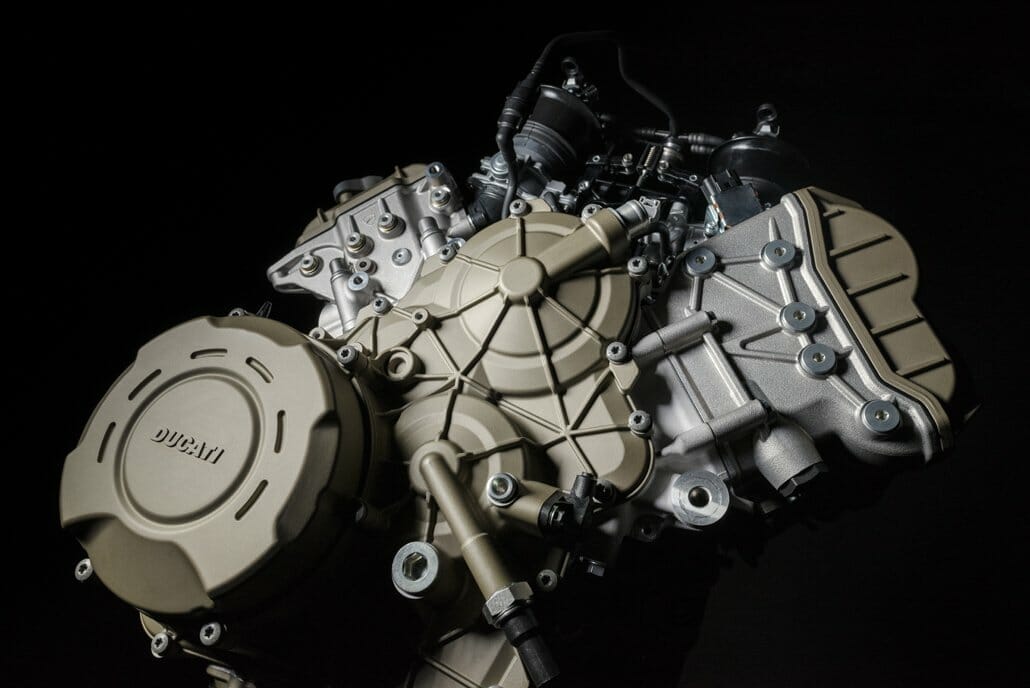Ducati introduced the new 90 degree V4 engine for the upcoming top models.
The Desmosedici Stradale is based on the engine of the MotoGP
[sam id=”2″ codes=”true”]The engine is based on the experience from MotoGP. The heart of the development were the cylinder heads of the MotoGP racing engine. Due to the same dimensions and design features, they have the same flow conditions. The installation will also be identical with the MotoGP. It is installed 42 degrees to the rear. This results in good mass centralization.The crankshaft rotates in the opposite direction to the direction of travel, thereby reducing the stabilizing centrifugal forces of the wheels, making the motorcycle more agile. In addition, it reduces the wheelie tilt during acceleration and the tendency of a lifting rear wheel when braking.
The crankshaft offset is 70 degrees. The “Twin Pulse” sequence (explanation below) is intended to provide a controllable power development with optimized traction at the curve output, ie during acceleration.
How much does the new Ducati V4 engine perform?
1.103 cc has the engine and thus has more displacement than the counterpart in the MotoGP. 155 kW respectively 210 HP , the Euro4 compliant engine delivers 13,000 rpm. Between 8.750 and 12.250 revolutions, more than 120 Nm of torque are permanently present. This means that the engine is also well-suited for road traffic, since this is usually used in the medium speed range.
The technology behind the new V4 engine
Of course, desmotronics is used to control the four valves per cylinder. The cylinder bore has a diameter of 81 mm. This is in accordance with the MotoGP regulations and the four-cylinder super sports segment. The throttle bodies are equipped with variable intake funnels in order to be able to adapt the length of the intake paths over the entire speed band. This is intended to improve the performance development and dosing.
The right mixture is controlled via oval throttle bodies with two injection nozzles upstream and downstream of the throttle valve. Thanks to the space saved by the compact engine, there is room for a water pump and a 12.8-liter airbox inside the V.
Semi-dry sump lubrication is used. Four pumps are used for this purpose. A chain-driven rotary pump delivers the oil as a pressure pump, and three pumps return the oil.
The motor is a co-supporting element of the frame
The Desmosedici Stradale is constructed as a supporting element of the frame. The frame is connected at the front with the upper crankcase halves, at the rear with the cylinder heads. The swingarm and strut are mounted directly in the crankcase.
The new Ducati engine weighs 64.9 kg and thus only 2.2 kg more than the 1.285cc Superquadro Twin.
Data from the Ducati Desmosedici Stradale V4 engine:
- 1.103 cm³ 90 degree V4 cylinder engine
- Bore x stroke 81 x 53.5 mm
- Compaction 14: 1
- Maximum output over 210 hp (155 kW) at 13,000 rpm
- Maximum torque over 120 Nm between 8.750 and 12.250 / min
- Euro 4
- Two overhead camshafts with chain-gear hybrid drive and dermodromic valve control, four valves per cylinder
- Counter-rotating crankshaft with 70 degrees crankshaft offset
- Multi-disc oil bath clutch with servo function
- Semi-dry sump lubrication with four oil pumps: one pressure pump and three return pumps
- Mixture preparation via four oval throttle bodies (equivalent Ø 52 mm) and variable intake funnel
- Six-speed transmission with DQS up / down system
- Long inspection intervals with “Desmo service” only every 24,000 km
- normal maintenance every 12,000 km or every 12 months
- Mit dem Motorrad Zentralständer kannst du dein komplettes Motorrad mühelos aufbocken und frei auf engstem Raum rangieren. Solide Doppelrollen sorgen dafür, dass du deine Maschine millimetergenau in...
- Technische Daten Zentralständer: 78cm lang, 54cm breit, 75,5cm hoch. Eigengewicht: 17kg. Max. Tragkraft: 300kg. Die max. Bodenfreiheit der Räder liegt im Bereich von 5-15cm, abhängig vom Modell.
- Im Lieferumfang des Motorrad Zentralheber ist der passende Adapter mit Anbauplatte für dein jeweiliges Modell enthalten. Bei Kauf eines neuen (zusätzlichen) Motorrades können weitere Adapter...
- Durch innenliegende Gleitschienen wird eine leichte Bedienung des Zentralständer Motorrad ermöglicht. Aufgrund der Entlastung von Reifen und Gabel im aufgebockten Zustand, kann der Power Evo auch...
- Hinweis: Zubehör wie z.B. Sturzbügel oder veränderte Fußrastenanlagen können dazu führen, dass der Ständer nicht genutzt werden kann. Bitte vor Kauf prüfen.
Letzte Aktualisierung am 2024-05-02 / *Affiliate Links / Bilder von der Amazon Product Advertising API
The TwinPulse ignition sequence
The engine has a crankshaft displacement of 70 degrees and produces a twin pulse ignition sequence. This corresponds to the operation of a double two cylinder. In each case, the two left and also the two right cylinders ignite almost the same. Ignition at 0 degrees, 90 degrees, 290 degrees, and 380 degrees. At 0 degrees the front cylinder ignites on the alternator side and at 90 degrees the rear cylinder on this side. This is followed by an interval in which no torque is generated until the two cylinders on the clutch side ignite. Also offset by 90 degrees.

